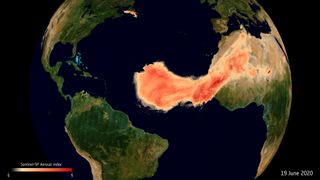Satellite sees 'Godzilla' dust plume sweep across the Atlantic Ocean
It started in the Sahara Desert.
Each year, dust from the Sahara Desert blows off Africa and across the Atlantic, but most years that plume isn't so massive it's nicknamed "Godzilla."
This June, the annual plume earned that nickname, as well as the title of the dustiest such event in the 20 years that scientists have kept records of these storms. All told, it contained between 60% and 70% more dust than a typical one of these plumes. It also traveled farther than the annual phenomenon, called the Saharan Air Layer, typically does.
The plume forms when thunderstorms and heavy winds pull dust up off the Sahara Desert beginning in late spring. The atmosphere then carries the dust away throughout the summer and into the early fall; how far the plume travels depends on local qualities of the atmosphere.
Related: The top 10 views of Earth from space

This year, the atmosphere carried the plume about 5,000 miles (8,000 kilometers), according to a statement from the European Space Agency (ESA), all the way out to the Caribbean islands and the southeastern United States.
ESA watched this year's dust plume throughout the month of July using its Copernicus Sentinel-5P satellite, a crucial component of its Earth-observation fleet. The satellite is tailored to study small particles in the air, like dust and pollutants.
Typically, much of the dust in the plume ends up sinking in the Atlantic Ocean, where it feeds tiny microscopic organisms called plankton. When it reaches land, the influx of dust can change the way ecosystems function, including by fertilizing the Amazon rainforest. It can also interfere with the formation of tropical storms and hurricanes, although it can be dangerous for humans to breathe in.
Get the Space.com Newsletter
Breaking space news, the latest updates on rocket launches, skywatching events and more!
Email Meghan Bartels at mbartels@space.com or follow her on Twitter @meghanbartels. Follow us on Twitter @Spacedotcom and on Facebook.
Join our Space Forums to keep talking space on the latest missions, night sky and more! And if you have a news tip, correction or comment, let us know at: community@space.com.

Meghan is a senior writer at Space.com and has more than five years' experience as a science journalist based in New York City. She joined Space.com in July 2018, with previous writing published in outlets including Newsweek and Audubon. Meghan earned an MA in science journalism from New York University and a BA in classics from Georgetown University, and in her free time she enjoys reading and visiting museums. Follow her on Twitter at @meghanbartels.
-
Wolfshadw Being a fan of the Big G-Man, unless it's moving in on Tokyo/Japan, it should not have that name. ;)Reply
-Wolf kids -
Helio Does this extensive dust cloud increase the heat content of our atmosphere (sunlight absorption) or decrease it (greater albedo over ocean)?Reply -
Wolfshadw I would think the dust cloud would have a cooling effect (blocking sunlight) on the ocean temps in the area; hopefully limiting the Atlantic tropical season.Reply
-Wolf sends
